
HOMEWesley Britton’s Books,
|
Spies on FilmSpies on Television & RadioSpies in History & LiteratureThe James Bond Files |
|
Spies on Television & Radio ~ Zorro the Spy – A
Photo Essay
By Rochelle Dubrow Introduction by Wesley Britton ~ 
In 1998, James Bond director Martin Campbell helmed the lavish and very entertaining The Mask of Zorro. In this version of the story, Don Diego de la Vega, the original Zorro (Anthony Hopkins), recruited a cocky street hoodlum (Antonio Bandaras) to take over the role of the masked avenger. Don Diego felt the evil Rafael Montero (Stewart Wilson) was up to nasty business in California, and he needed help from a younger man. In particular, Don Diego wanted a spy inside Montero’s household, and saw Bandaras as a brash youth with promise. Hopkins not only trained the young man in swordcraft, but in the etiquette and style of a Spanish nobleman to infiltrate Montero’s inner circle. At the same time, Hopkins took on the guise of Bernardo, supposedly Bandaras’ servant, to also snoop around the Montero household. In the end, the pair foiled an elaborate plot by a villain as colorful and demonic as any adversary faced by 007. These two screen Zorros shared much with other larger-than-life secret agents fighting powerful megalomaniacs by taking on cover identities, acting as saboteurs, and living the double life of a spy. Of course, the undercover operations of Zorro had begun long before the 1998 film. Johnston McCulley’s “Zorro” character first appeared in the 1919 The Curse of Capistrano, which had been a serialized story in the pulp magazine, All-Story Weekly. In his debut, Zorro began as a highwayman in the Robin Hood mold until he fermented a revolution against the deceitful Capt. Ramone. With the success of Douglas Fairbanks’ 1920 film, The Mark of Zorro (which became the title for Curse when it was published as a novel), McCulley wrote more stories first primarily for Argosy and then West magazines until 1951. 
Guy Williams was the most famous incarnation of Zorro in the late 1950s. From 1920 on, the story of Zorro has been redone and re-molded in many ways in silent films, the talkies, on television, and in nearly every language. Without question, the most beloved adaptation of the legend was the Walt Disney produced television series (ABC, 1957 to 1959). Guy Williams became synonymous with the role in two seasons of 30-minute and four one-hour adventures (78 in all) before legal matters ended Disney’s access to the rights. George J. Lewis, who’d played a government agent in the extremely odd Zorro’s Black Whip (a 1944 Republic Pictures serial with a female Zorro-type character), now played Don Alejandro de la Vega, father of a son he thinks is evading social responsibility. Henry Calvin was Sgt. Demetrio Lopez Garcia, and Gene Sheldon was Diego’s faithful confidant, Bernardo. In 2007, the Disney series celebrated its 50th Anniversary, and part of the celebration will be the publication of A Collector’s Guide to ZORRO from the 50s and 60s by Rochelle Dubrow, an update of her 2005 A Guide to ZORRO from the Fifties and Sixties. 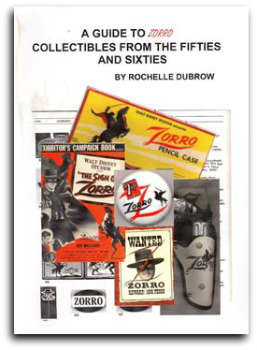
The new edition has been published by BearManor Media in March 2008, and all Zorro aficionados will welcome this contribution by an expert on the show. Dubrow is among many Baby Boomers who were enthralled by the swashbuckling adventures of Zorro during its original run, and was a lover of the merchandise now commanding high prices on eBay and in antique shops everywhere. Her interest never died, and when Disney opened its Vault Disney and began showing Zorro on television once more, she was hooked again. About ten years ago, she decided she would search out the many Zorro collectibles from the fifties and sixties which lead to the creation of her two books. Rochelle clearly believes Zorro was indeed a spy, and to prove it, she told us at Spywise she could make her points in pictures. So here is her photo essay uncovering the elements of a unique espionage operator in a mask and cape. Editor’s Note ~ The first episodes Rochelle describes were made into a theatrical film, The Sign of Zorro in 1960.) 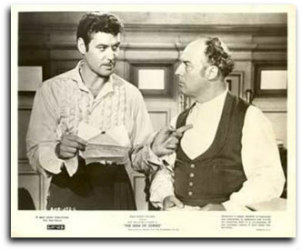
Guy Williams and Gene Sheldon in a scene from “The Sign of Zorro” (1960). As a child I watched a great deal of television and one character stood out – the ultimate spy of nineteenth century Spanish California. El Zorro – The Fox – rode mysteriously out of the night cloaked in black, his face covered by a mask, to right the wrongs brought against the poor and innocent. By day, his alter persona, Diego de la Vega, was the ineffectual son of a prominent landowner but by night he became Zorro, a master of the sword and whip. He played his dual roles so well that his own father, close friends and even his enemies could not see the connection between the two. Deception and secrecy followed him, just like any spy, even though without masks or capes. Zorro did not work for any government agency or military power. He was not looking for money, power or glory. He was a man with high morals and ethical values. Zorro was a mere mortal, born at a time when technological advances did not exist. He had no superpowers. He did not need them – for he had intelligence, fortitude, and a gift with the sword and whip. Whether Zorro was uncovering clues to the identity of a young girl’s father or protecting a Chinese runaway, Zorro would appear to help rectify the situation. 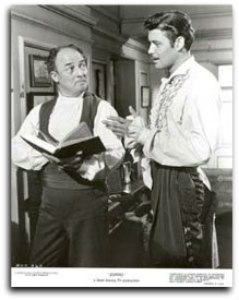
Gene Sheldon as Bernardo and Guy Williams as Zorro (1957). Rich or poor, young or old, he treated everyone as an equal. He was a man to look up to; a hero. For lovers of the Disney incarnation of the character, it all began in September 1957. In the first episodes set in 1820, Don Diego (Guy Williams) arrived in Monterey sailing home from Spain. The ship’s captain warned him of a cruel military dictator running his once peaceful pueblo. After re-reading the letter his father sent asking him to return home, Diego realized that there was trouble brewing. He formulated a plan to work undercover to put an end to this tyrant. He knew an outward show of force arranged by his father would only be crushed by the military. Diego’s plan involved taking on another persona. He transformed himself into a man interested only in books and poetry, but Zorro was the man he was meant to be . . . forceful and skilled with sword and whip. In his fight he was aided by Bernardo (Gene Sheldon), his mute servant. A quick wit himself, Bernardo decided to change as well. He became the eyes and ears behind his master. Shortly after he began his covert operations, Diego found himself face to face with the dictator in his own home. Monastario (Britt Lomond) brought a copy of Zorro’s costume to the de la Vega hacienda to have every young man try on the outfit. Monastario believed he would be able to recognize the real Zorro. 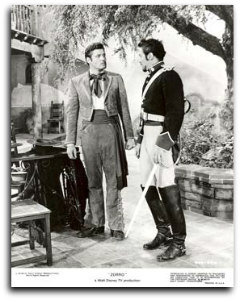
Gene Sheldon as Bernardo and Guy Williams as Zorro (1957). In order to misdirect the cruel tyrant from himself, Diego ineptly tried on the costume becoming entangled in the cape. Zorro defeated Monastario through persistence, cunning undercover work, and use of counter-intelligence. Reporting to Monastario was Sgt. Garcia, a good man who liked his wine. Over a glass or two and a little friendly conversation he became an easy mark for Diego to learn key information or to pass on misinformation. Many spies and superheroes have accomplices who aid them in their work. Batman had Robin and Green Hornet had Kato. Bernardo, Diego’s trusty servant and friend, worked with him. Like Diego, Bernardo’s performance as a “deaf” mute was flawless. He was able to gather important information that Diego could not by eavesdropping on unsuspecting individuals and then passing the information to Diego through gestures and pantomime. Bernardo may have been a “silent” partner but he was most definitely a much needed one. Editor’s Note ~ The following episodes were edited into the theatrical release, Zorro the Avenger, in 1959 with Charles Korvin as the nemesis, “The Eagle.”) Throughout the series, Zorro found himself up against a variety of villains. Some were easily uncovered but one enemy known as “The Eagle” took all our heroes’ abilities to reveal. He was the most complex of Zorro’s nemeses. A single clue sent Zorro spiraling toward a deadly conspiracy where he faced danger, adventure, romance and a long list of unforgettable adversaries. Zorro tried without success to figure out the common thread – a cut feather, which linked a series of crimes; an assassination, a payroll robbery, the murder of a stranger and missing gunpowder. Diego and Bernardo became suspicious of the new Administrator assigned to the pueblo after he insisted on making the de la Vega hacienda his temporary headquarters. When the Administrator’s attaché case opened and revealed several uncut feathers and a letter addressed to “The Eagle”, Zorro sought the truth regarding his unwanted houseguest. Editor’s Note ~ Disney released the four episodes described below on VHS under the title Invitation to Death.) 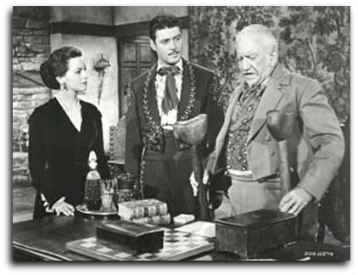
Joan Evans (Leonar), Guy Williams (Zorro), and John Litel (the Governor), 1959. In another group of episodes, Zorro and Bernardo encountered assassins, deception and greed. It began when assassins attempted to kill the Governor of California near Los Angeles. The governor’s guards, led by his aid Capitan Arrellanos, sought immediate help for the badly injured man at the de la Vega hacienda. While the governor healed, Capitan Arrellanos was asked to take his place. With guards surrounding the hacienda, Diego and his father were satisfied that everything was secure. However, when the good Capitan began taking his new position too seriously, Diego and Bernardo decided to take precautions. Hiding in the secret passageway, Bernardo soon learned that the governor’s aid had betrayed him. There would be an attempt on the governor’s life. Having prevented the attack, they realized that others would follow. The governor continued to improve but was restless. His daughter, Leonar, continued to use a music box at his bed to lull her father into a deep sleep, much to Diego’s amazement. While the governor slept, an assassin entered his room with a knife. Hiding in the passageway, Bernardo swung open the door and hit him with a vase. The governor, still asleep, is moved by Zorro and Bernardo into the passageway while the music played. When two other assailants arrived, one took out a knife and stabbed the unconscious assailant Zorro placed in the governor’s bed. The two men escaped. Having made new plans, Arrellanos dismissed all the guards and had Diego and his father called away from the hacienda. Diego slipped back and changed into Zorro while Bernardo continued to observe Arrellanos. Diego and Bernardo knew another attempt would take place that evening. After allowing five men to enter the house, Arrellanos grabbed and tied up Leonar. In order to save the governor, Bernardo turned on the music box and waited for the governor to fall asleep. He moved the governor, couch and all, into the passageway while Zorro picked off the would-be assassins one man at a time. Zorro then caught up to Arrellanos and with Bernardo’s help, Zorro put an end to Arrellanos and his reign of terror. For more on Rochelle and her books, see “The Sign of the Z”, Toy Collector Magazine, published by QM4G Media. Rochelle’s tribute to Britt Lomond can be found in Scary Monsters Magazine – Issue 64, October 2007. Rochelle’s Zorro fanfic pages. Rochelle Dubrow’s book A Collector’s Guide to ZORRO from the 50s and 60s is available in bookstores everywhere, as well as these online merchants ~
Amazon U.S.
Photographs courtesy of Rochelle Dubrow. |